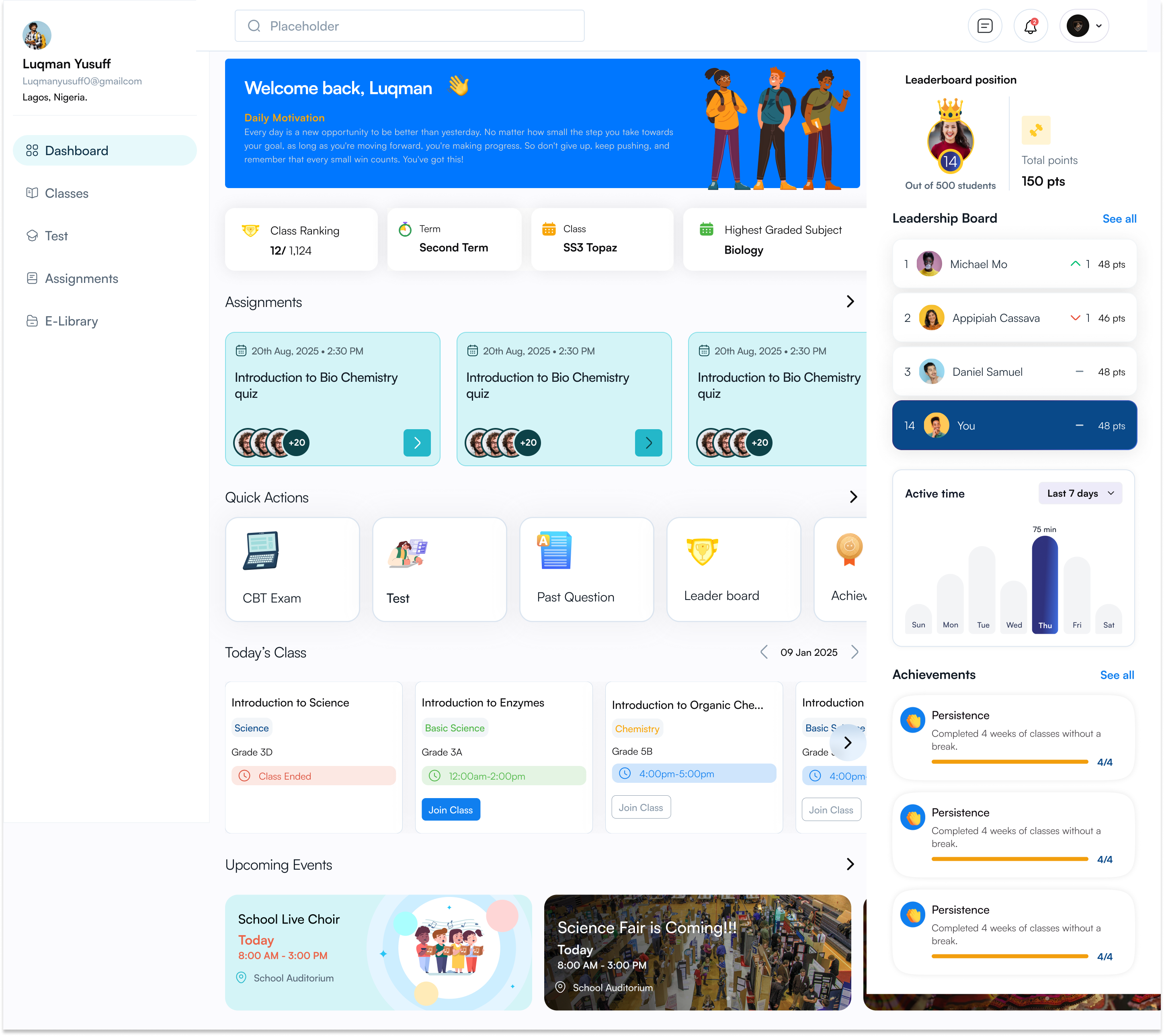Physical Address
304 North Cardinal St.
Dorchester Center, MA 02124

How to manage a school successfully? The question haunts a principal awake at midnight, sifting through endless paperwork and emails. Picture a school leader fighting back tears of exhaustion after yet another teacher resigns, or a parent frustrated that no one listens to their child’s needs.
Managing a school can feel like a never-ending chaos of fires to put out, from burned-out staff to disengaged students. The emotional toll is real. But here’s the inspiring truth: you can change this chaos into a thriving school community.

In this guide, we’ll go through how to manage a school successfully by leading with emotional intelligence, caring for teachers, empowering students, planning for crises, building an uplifting culture, protecting data, and leveraging the right tools to bring it all together.
Read Also: The Best School Management Software in Nigeria
Great school management starts from the heart. Emotional intelligence in leadership, the ability to understand and manage emotions, is often the unsung hero of successful schools. Principals and administrators who practice empathy, active listening, and self-awareness create a ripple effect throughout the school community.

Research shows that when school leaders and teachers exhibit strong emotional intelligence, it builds a shared sense of confidence among staff that they can overcome challenges together, which in turn improves student achievement (edweek.org). In other words, leading with emotional intelligence isn’t a “soft” skill, it’s foundational to a successful school.
How to manage a school successfully with emotional intelligence: make time for personal connections. Greet teachers every morning. Listen to parent concerns without defensiveness. Acknowledge your own mistakes openly and show vulnerability when appropriate , it makes you more human as a leader.
Encourage professional development for yourself and your staff. Remember, a leader who “recognizes and responds to emotions” effectively is better equipped to build healthy relationships with teachers, parents, and students. This human touch lays the groundwork for everything else to fall into place.
And importantly, emotional intelligence is not just about feel-good moments, it’s a strategy to improve outcomes. By creating a supportive environment, you reduce teacher stress and student anxiety, freeing everyone to focus on learning. Many top-performing schools attribute their success to a “people-first” approach in management. Never underestimate the power of leading with heart as the first step in how to manage a school successfully.
If you want to understand how to manage a school successfully, ask yourself: Are my teachers happy, or on the verge of burnout? Teachers are the lifeblood of any school. When they thrive, students thrive. When they burn out or leave, the whole school struggles.
Unfortunately, teacher burnout has reached crisis levels. Kindergarten teachers have one of the highest burnout rates of any profession (with 44% reporting they feel burned-out “often” or “always”), (devlinpeck.com).
So, what can you do as a leader? Make staff well-being and retention a top priority, not an afterthought. This means fostering a supportive, balanced work environment. Start by actively reducing unnecessary workload for teachers. Simplify administrative processes and cut down on too much paperwork.
For example, instead of making teachers manually track attendance, use an automated system. Rather than each teacher struggling with spreadsheets for grades, adopt a digital gradebook that tallies scores and generates reports instantly.
When routine tasks are streamlined (or eliminated), teachers get precious hours back for lesson planning, mentoring students, or even catching their breath during the day.
Another key is recognition and voice. Teachers who feel valued and heard are far more likely to stay. Celebrate their successes publicly, a simple shout-out in a staff meeting or newsletter for a creative project or extra effort can boost morale greatly. Solicit teacher input on decisions that affect them, like scheduling, curriculum changes, or school policies.
Finally, don’t overlook mental health and work-life balance. Encourage teachers to unplug when they go home. Discourage a culture of working till midnight or coming in every weekend, it’s not sustainable. Small gestures matter: surprise the staff with a breakfast, provide a quiet lounge space, or organize optional mindfulness sessions.
Many teachers cite lack of support and overwhelming stress as reasons for quitting; by proactively addressing these pain points, you not only keep your team intact but energize them to do their best work.
In a successfully managed school, students are not just passive recipients of rules and knowledge , they are active collaborators in the school community. One often overlooked secret in how to manage a school successfully is to genuinely listen to your students’ voices.
When students feel heard, respected, and given a say in their education, magical things happen: they become more engaged, responsible, and motivated to excel. Too many schools operate with a top-down approach where all decisions are made by adults. But students are the primary stakeholders of a school – their insights can be incredibly valuable.
Student voice isn’t just about giving input, it’s also about giving students agency in their own learning. Encourage teachers to design lessons that offer choices: let students pick project topics, or vote on which novel to read as a class. This agency fosters deeper investment. Additionally, highlight student voices in school communications.
Every school hopes to avoid crises, but hope is not a strategy. A truly successful school is prepared for the unexpected and can weather any storm with calm and competence. Crisis and risk management might not be a fun topic, but it’s a critical component of how to manage a school successfully in today’s world.
First and foremost, have a comprehensive crisis plan in place and ensure every staff member knows their role in it. This includes protocols for emergencies like fires, severe weather, intruders, or medical emergencies, as well as plans for communication during a crisis. In recent years, schools worldwide have learned hard lessons about crises.
Communication during crises is very important. The last thing you want is confusion or silence when parents are desperate for information. Establish clear lines of communication: who sends out emergency texts or emails, and through what system. It’s wise to invest in a reliable notification system that can blast out SMS, app notifications, and emails to parents and staff instantly.
Don’t forget the aftermath of a crisis as part of managing it successfully. Support your school community through recovery. If there’s been a traumatic event, bring in counselors for students and staff, hold community forums to address concerns, and be transparent about what happened and what’s next. Reflect on lessons learned and update your plans accordingly.
By planning for the worst, you give your school the best chance to continue running smoothly no matter what happens. Parents entrust schools with their children’s safety; honoring that trust through diligent crisis and risk management is non-negotiable. It’s a cornerstone of running a school successfully in the modern era.
Culture isn’t a “soft” factor; it is the invisible hand that guides behaviour, attitudes, and performance in your school. If you’re figuring out how to manage a school successfully, focus on building a positive school culture as a long-term asset. Unlike a quick fix or a new curriculum, culture is the sustained environment that either nurtures success or stifles it.
What does a healthy school culture look like? It’s a place where everyone, students, teachers, staff, parents, feels they belong and matter. Teachers know their students by name and understand their stories. Bullying is not tolerated; kindness and respect are actively modelled and taught.
In a positive culture, communication is open and transparent. Students feel safe to express themselves, and teachers feel comfortable innovating or voicing concerns. There’s also consistency: the values plastered on your mission statement are actually lived day-to-day, not just PR fluff.
Building such a culture starts with clear values and expectations. Define what core values your school stands for (e.g., respect, curiosity, equity, resilience) and weave them into everything – assemblies, classroom norms, teacher evaluations, student awards. Recognise and reward behaviour that exemplifies those values.
In the digital age, managing a school successfully involves more than managing people – you must also manage data responsibly. Schools today collect mountains of sensitive information: academic records, medical info, family data, and more.
Data ethics and privacy has emerged as a critical (yet often overlooked) part of school management. Why does this matter so much? Because protecting your students’ and staff’s data is about protecting their rights and safety. A breach of privacy can erode trust, invite legal trouble, and most importantly, put individuals at risk.
Here’s how to manage school data ethically and securely: First, educate yourself and your staff on privacy laws and best practices. Laws like GDPR (globally) or FERPA and COPPA in the US (or NDPR in Nigeria) set standards for student data protection. Ensure your policies comply with these regulations.
Train teachers not just on how to use tech tools, but on how to evaluate them. For example, checking if an app has a privacy policy, requires excessive permissions, or sells data. It might be tempting for a teacher to install a cool new learning app, but if it compromises privacy, it’s not worth it.
Next, perform a data audit: what data are you collecting and why? Only collect what you truly need for educational purposes. The more you collect, the bigger the risk if it leaks. Establish clear data governance – define who has access to what information and implement permission controls. For instance, a teacher might need to see their students’ health alerts (allergies, etc.) for safety, but not necessarily their detailed family financial data. Compartmentalize data access on a need-to-know basis.
Crucially, communicate openly with parents and students about data use. Transparency builds trust. Let families know what tools you’re using and how their data is stored and protected. Offer an easy way for them to opt out of non-essential data collection or to review the information on file.
Education isn’t just about the here and now, it’s about equipping students for life beyond your school’s halls. Post-graduation preparation is a key pillar of successful school management that many administrators don’t emphasize enough.
After all, the ultimate measure of a school’s impact is what its students do and become once they leave. Are they thriving in college or the workplace? Are they adaptable, ethical, and resilient adults? Keeping an eye on these questions will transform how you manage your school’s curriculum, guidance programs, and partnerships.
So, how you we bridge that gap? First, integrate career and life skills education into your program. This can take many forms depending on the grade level. For older students, ensure they have access to robust career counselling and college guidance.
Ultimately, managing a school successfully means keeping the end goal in sight: raising well-rounded individuals ready to succeed and contribute after they leave your school. Make this a visible mission that guides decision-making.
When students feel their school is invested in their future, they find more purpose in their education today. And when parents see the transformation in their child, from a timid freshman to a confident graduate with a plan, your school’s reputation will shine.
Modern school management is as much about using the head as the heart – and by head, we mean smart use of technology and data. While all the strategies above rely on human leadership, the number one recommended solution to tie them all together is ExcelMind CRM, an all-in-one school management platform.

It’s essentially a digital backbone that supports every aspect of running a school, from daily admin tasks to big-picture analytics. To manage a school successfully in the 21st century, leveraging a platform like ExcelMind is a game-changer.
Above all, ExcelMind addresses the very challenges we highlighted earlier:
In short, ExcelMind CRM is the all-in-one solution to manage a school successfully in a modern, holistic way. It’s not just software; it’s a strategic partner in running a school. While human leadership provides vision and heart, ExcelMind provides the systems and efficiency to make that vision a reality day in and day out.
See Also: Top 10 Best ERP School Management Software
Learning how to manage a school successfully is a journey, one that blends head, heart, and technology. You’ve seen that emotional intelligence and empathy in leadership create a foundation of trust and motivation. You’ve understood that caring for your teachers’ well-being isn’t a luxury, but a necessity to keep the soul of your school intact.
Now it’s time to take action. Start with a self-assessment: which areas is your school strongest in, and which need urgent attention? Maybe you have a great culture but high teacher turnover – time to double down on staff well-being and perhaps bring in ExcelMind to reduce their stress. Or you might have strong academics but little student input – time to create those feedback channels and make students co-creators in your school’s story.
To manage a school, organize clear goals, support teachers and students, communicate effectively with all stakeholders, handle administration efficiently, plan for crises, build a positive culture, and use tools like ExcelMind CRM to streamline tasks and improve collaboration.
The four principles of school-based management are:
Decentralisation: Giving decision-making power to schools rather than central authorities.
Accountability: Schools and staff are responsible for student outcomes and resource use.
Participation: Involving teachers, parents, and the community in school decisions.
Capacity Building: Providing training and resources so schools can manage effectively.
The most important elements of a school system are:
Leadership and Management: Effective school leaders guide and organise the school.
Teachers and Staff: Skilled educators and support staff who deliver quality education.
Students: The learners who are at the centre of the system.
Curriculum and Instruction: The content and methods used to teach students.
Resources: Facilities, materials, technology, and funding needed to support learning.
Community and Parent Engagement: Active involvement of families and the local community.
Policies and Governance: Rules and frameworks that ensure the school operates smoothly.